中国古典音乐 China classical music
- 格式:ppt
- 大小:2.60 MB
- 文档页数:27
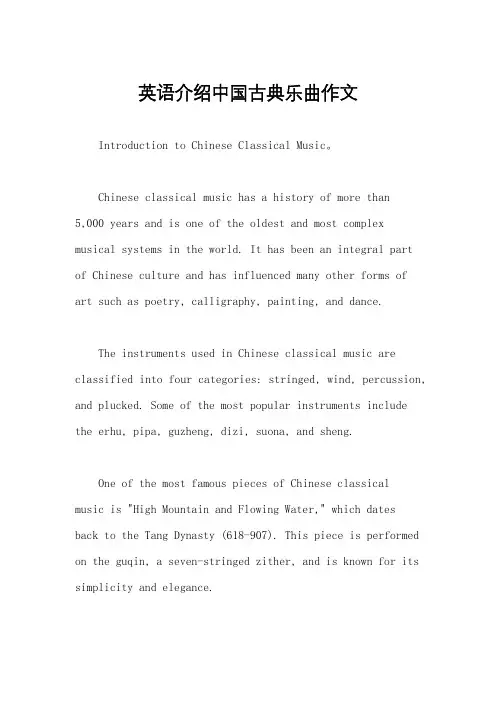
英语介绍中国古典乐曲作文Introduction to Chinese Classical Music。
Chinese classical music has a history of more than5,000 years and is one of the oldest and most complex musical systems in the world. It has been an integral partof Chinese culture and has influenced many other forms ofart such as poetry, calligraphy, painting, and dance.The instruments used in Chinese classical music are classified into four categories: stringed, wind, percussion, and plucked. Some of the most popular instruments include the erhu, pipa, guzheng, dizi, suona, and sheng.One of the most famous pieces of Chinese classicalmusic is "High Mountain and Flowing Water," which datesback to the Tang Dynasty (618-907). This piece is performed on the guqin, a seven-stringed zither, and is known for its simplicity and elegance.Another popular piece is "Ambush from Ten Sides," which was composed during the Han Dynasty (206 BC-220 AD) and tells the story of a battle between two generals. The piece is performed on the sheng, a reed instrument, and is known for its dramatic and powerful sound.In addition to these traditional pieces, Chinese classical music has also evolved to include modern compositions that blend traditional Chinese instruments with Western orchestral instruments. One example is "Butterfly Lovers," a violin concerto that tells a tragic love story and is one of the most popular pieces of classical music in China.Overall, Chinese classical music is a rich and diverse art form that continues to influence and inspire people around the world. It is a testament to the enduring beauty and power of Chinese culture.。
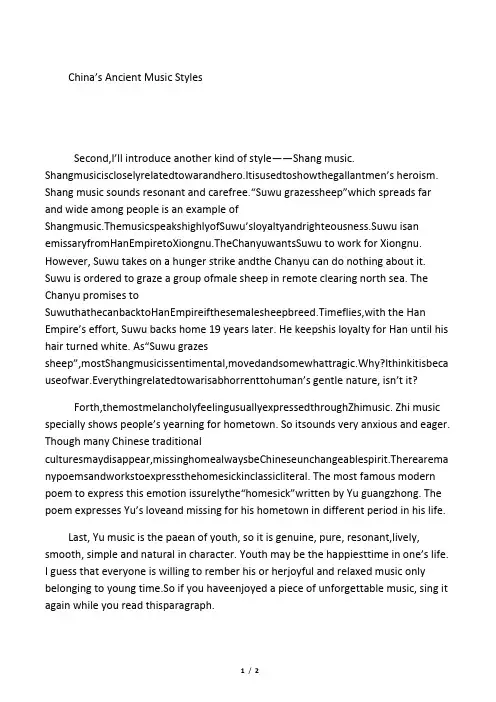
China’s Ancient Music StylesSecond,I’ll introduce another kind of style——Shang music. Shangmusiciscloselyrelatedtowarandhero.Itisusedtoshowthegallantmen’s heroism. Shang music sounds resonant and carefree.“Suwu grazessheep”which spreads far and wide among people is an example ofSha ngmusic.ThemusicspeakshighlyofSuwu’sloyaltyandrighteousness.Suwu isan emissaryfromHanEmpiretoXiongnu.TheChanyuwantsSuwu to work for Xiongnu. However, Suwu takes on a hunger strike andthe Chanyu can do nothing about it. Suwu is ordered to graze a group ofmale sheep in remote clearing north sea. The Chanyu promises to SuwuthathecanbacktoHanEmpireifthesemalesheepbreed.Timeflies,with the Han Empire’s effort, Suwu backs home 19 years later. He keepshis loyalty for Han until his hair turned white. As“Suwu grazessheep”,mostShangmusicissentimental,movedandsomewhattragic.Why?Ithinkitisbeca useofwar.Everythingrelatedtowarisabhorrenttohuman’s gentle nature, isn’t it?Forth,themostmelancholyfeelingusuallyexpressedthroughZhimusic. Zhi music specially shows people’s year ning for hometown. So itsounds very anxious and eager. Though many Chinese traditionalculturesmaydisappear,missinghomealwaysbeChineseunchangeablespirit.Therearema nypoemsandworkstoexpressthehomesickinclassicliteral. The most famous modern poem to express t his emotion issurelythe“homesick”written by Yu guangzhong. The poem expresses Yu’s loveand missing for his hometown in different period in his life.Last, Yu music is the paean of youth, so it is genuine, pure, resonant,lively, smooth, simple and natural i n character. Youth may be the happiesttime in one’s life.I guess that everyone is willing to rember his or herjoyful and relaxed music only belonging to young time.So if you haveenjoyed a piece of unforgettable music, sing it again while you read thisparagraph.Five types of Chinese classical music——Gong, Shang, Jue, Zhi andYu are as beautiful as other arts, we may can’t understand it very well, butit has no effect on us enjoying music. Just as most people have noabilitytoreadmusicbook,theyareabletoenjoymusicwell.Ihopethatmypapercouldhelpyo uknowchina’sancientmusiccultureandfireyourinterest to have it.。

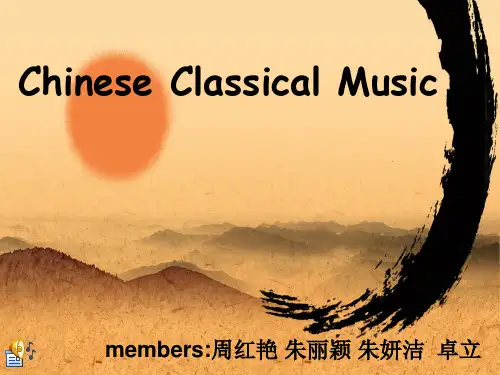
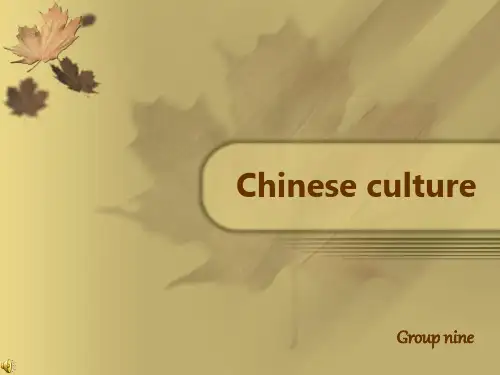
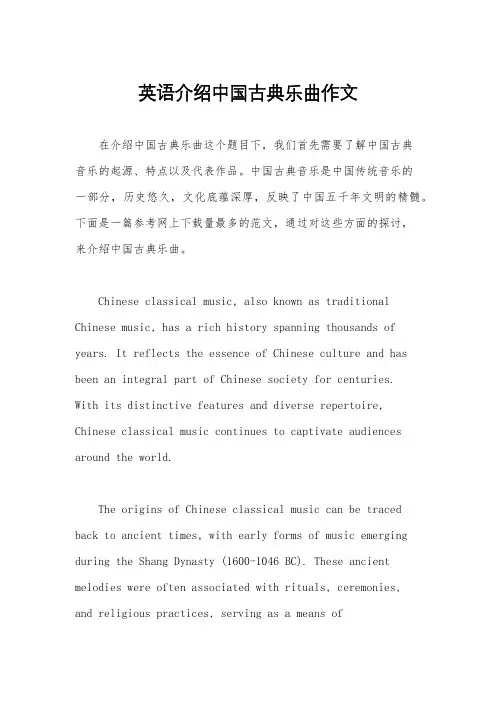
英语介绍中国古典乐曲作文在介绍中国古典乐曲这个题目下,我们首先需要了解中国古典音乐的起源、特点以及代表作品。
中国古典音乐是中国传统音乐的一部分,历史悠久,文化底蕴深厚,反映了中国五千年文明的精髓。
下面是一篇参考网上下载量最多的范文,通过对这些方面的探讨,来介绍中国古典乐曲。
Chinese classical music, also known as traditional Chinese music, has a rich history spanning thousands of years. It reflects the essence of Chinese culture and has been an integral part of Chinese society for centuries.With its distinctive features and diverse repertoire, Chinese classical music continues to captivate audiences around the world.The origins of Chinese classical music can be traced back to ancient times, with early forms of music emerging during the Shang Dynasty (1600-1046 BC). These ancient melodies were often associated with rituals, ceremonies,and religious practices, serving as a means ofcommunication with the divine. Over time, Chinese music evolved, incorporating elements from various dynasties and regions, resulting in a diverse range of styles and genres.One of the defining characteristics of Chineseclassical music is its emphasis on melody and expression. Unlike Western classical music, which often focuses on harmony and structure, Chinese music places greater importance on melodic variations, subtle nuances, and emotional depth. This emphasis on melody allows performersto convey a wide range of emotions, from joy andcelebration to sadness and introspection.Another distinctive feature of Chinese classical musicis its use of traditional instruments, many of which have been used for centuries. These instruments include the pipa, guqin, erhu, dizi, and guzheng, each with its unique sound and timbre. The pipa, for example, is a pear-shaped lutewith four strings, while the guqin is a seven-stringedzither known for its delicate tones. These instruments are often played together in ensembles, creating intricate harmonies and textures that are characteristic of Chinesemusic.Chinese classical music is also known for its rich repertoire of traditional melodies and compositions. These pieces often draw inspiration from nature, literature, poetry, and philosophical concepts, reflecting the cultural heritage and artistic sensibilities of the Chinese people. One of the most famous classical compositions is "High Mountains and Flowing Water," a guqin piece dating back to the Tang Dynasty (618-907 AD). This evocative melody depicts the majestic beauty of nature, with cascading notes and flowing rhythms that transport listeners to distant landscapes.In addition to its traditional repertoire, Chinese classical music has also undergone modernization and innovation in recent years. Contemporary composers and musicians have sought to preserve and revitalizetraditional music while also exploring new techniques and styles. This fusion of tradition and innovation has led to the emergence of new genres such as Chinese fusion, blending traditional instruments with modern elements suchas electronic music and jazz.In conclusion, Chinese classical music is a treasure trove of cultural heritage and artistic expression. With its rich history, distinctive features, and diverse repertoire, it continues to inspire and enchant audiences both in China and around the world. As we celebrate the legacy of Chinese classical music, we honor the enduring beauty and vitality of one of the world's oldest musical traditions.。
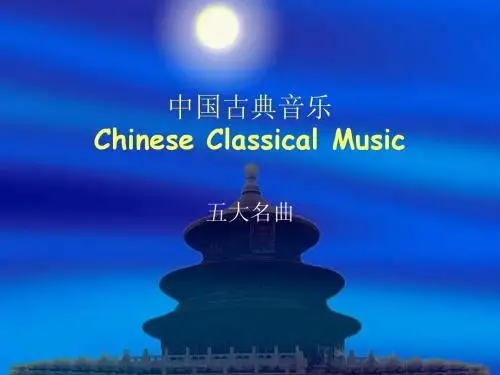
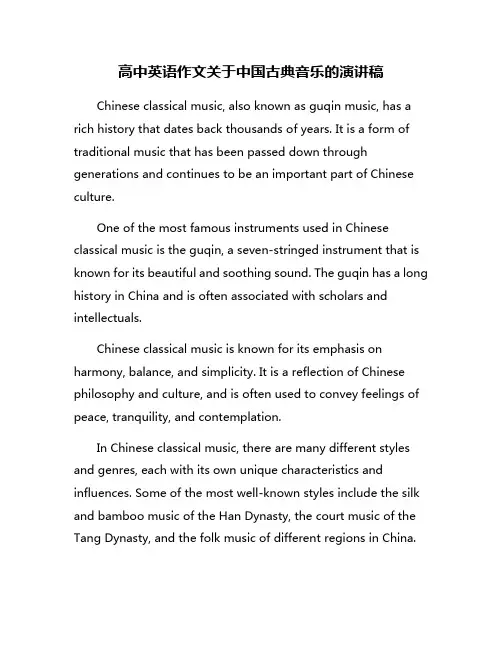
高中英语作文关于中国古典音乐的演讲稿Chinese classical music, also known as guqin music, has a rich history that dates back thousands of years. It is a form of traditional music that has been passed down through generations and continues to be an important part of Chinese culture.One of the most famous instruments used in Chinese classical music is the guqin, a seven-stringed instrument that is known for its beautiful and soothing sound. The guqin has a long history in China and is often associated with scholars and intellectuals.Chinese classical music is known for its emphasis on harmony, balance, and simplicity. It is a reflection of Chinese philosophy and culture, and is often used to convey feelings of peace, tranquility, and contemplation.In Chinese classical music, there are many different styles and genres, each with its own unique characteristics and influences. Some of the most well-known styles include the silk and bamboo music of the Han Dynasty, the court music of the Tang Dynasty, and the folk music of different regions in China.The performance of Chinese classical music is often a highly skilled and emotional experience. Musicians must have a deep understanding of the music and its history, as well as the ability to express emotions through their playing. Many musicians spend years studying and practicing in order to master the art of Chinese classical music.In recent years, Chinese classical music has gained popularity both in China and around the world. There are many schools that teach traditional Chinese music, and many musicians are incorporating elements of Chinese classical music into contemporary music styles.As we continue to embrace the beauty and richness of Chinese classical music, it is important to remember its long history and cultural significance. By studying and appreciating this ancient art form, we can gain a greater understanding of Chinese culture and history, and continue to preserve and pass down this beautiful tradition for future generations to enjoy.。
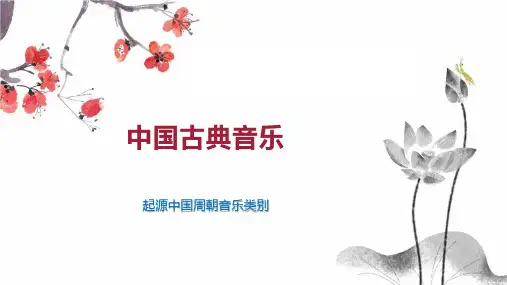
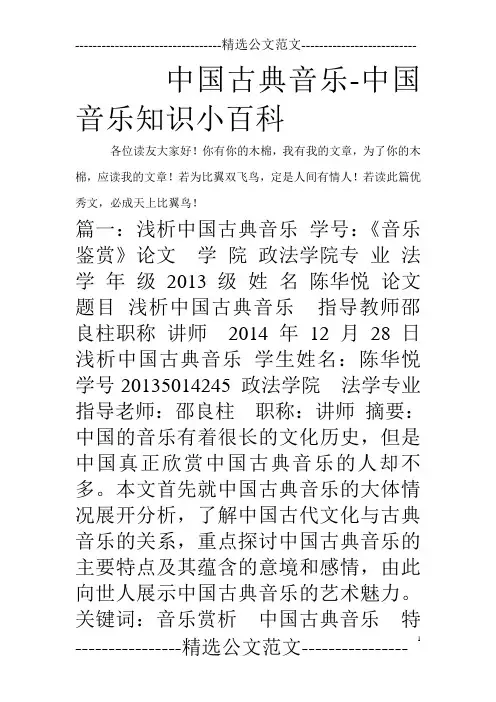
中国古典音乐-中国音乐知识小百科各位读友大家好!你有你的木棉,我有我的文章,为了你的木棉,应读我的文章!若为比翼双飞鸟,定是人间有情人!若读此篇优秀文,必成天上比翼鸟!篇一:浅析中国古典音乐学号:《音乐鉴赏》论文学院政法学院专业法学年级2013级姓名陈华悦论文题目浅析中国古典音乐指导教师邵良柱职称讲师2014年12 月28 日浅析中国古典音乐学生姓名:陈华悦学号20135014245 政法学院法学专业指导老师:邵良柱职称:讲师摘要:中国的音乐有着很长的文化历史,但是中国真正欣赏中国古典音乐的人却不多。
本文首先就中国古典音乐的大体情况展开分析,了解中国古代文化与古典音乐的关系,重点探讨中国古典音乐的主要特点及其蕴含的意境和感情,由此向世人展示中国古典音乐的艺术魅力。
关键词:音乐赏析中国古典音乐特点影响Abstract: China music has a long cultural history, but Chinese appreciate classical music Chinese person but not much. Firstly, the general situation China classical music to analyze, understand the relationship Chinese ancient culture and classical music, focusing on the main characteristics of Chinese classical music and its artistic conception and the feelings contained, thus to show the world the charm of art and appreciation of classical music China method. Keywords: music appreciation Chinese classical music Characteristic Influence 中国古典音乐有悠久的历史传统,中华民族在几千年的历史长河中创造了无比丰富的民族音乐文化。

中国古典音乐的英文作文Classical Chinese MusicChina has a rich and diverse musical heritage that dates back thousands of years. From the ancient court music of the imperial dynasties to the folk melodies that have been passed down through generations, Chinese classical music is a reflection of the country's rich cultural tapestry. In this essay, we will explore the history, characteristics, and enduring influence of this ancient art form.At the heart of Chinese classical music lies a deep respect for tradition and a reverence for the natural world. Many of the earliest musical forms were closely tied to religious and ceremonial practices, with the sounds of various instruments and vocal styles used to invoke the spirits and celebrate the changing of the seasons. The pentatonic scale, which features five notes rather than the seven found in Western music, is a defining feature of much of this repertoire, lending a unique and haunting quality to the melodies.One of the most iconic instruments in Chinese classical music is the guqin, a seven-stringed zither that has been played for over 3,000 years. Revered as the "instrument of the sages," the guqin wastraditionally played by scholars and philosophers as a means of cultivating inner peace and contemplating the natural world. The music of the guqin is characterized by its subtlety and nuance, with players using a variety of techniques to produce a rich tapestry of sounds that evoke the ebb and flow of nature.Another important instrument in the Chinese classical tradition is the erhu, a two-stringed fiddle that is often referred to as the "Chinese violin." The erhu is known for its expressive and emotive tone, which can range from the plaintive and melancholic to the joyful and celebratory. Erhu music has been used to accompany a wide range of traditional Chinese art forms, from opera and dance to storytelling and poetry recitation.In addition to these iconic instruments, Chinese classical music also features a rich array of percussion instruments, including the powerful and thunderous drums, the delicate and resonant gongs, and the melodic chimes and bells. These instruments play a crucial role in the performance of traditional Chinese opera, which is a highly stylized and complex art form that combines music, dance, and drama.One of the most distinctive features of Chinese classical music is its emphasis on improvisation and spontaneity. Unlike the highly structured and notated music of the Western classical tradition,much of the Chinese repertoire is based on a set of modal scales and melodic patterns that serve as a foundation for improvisation and personal expression. This allows for a great deal of flexibility and creativity in performance, with musicians drawing on their own experiences and interpretations to bring the music to life.Despite the rich and varied history of Chinese classical music, the art form has faced numerous challenges in the modern era. The upheavals of the 20th century, including the Cultural Revolution and the rapid modernization of Chinese society, have threatened the survival of many traditional musical forms and practices. However, in recent decades, there has been a renewed interest in preserving and revitalizing this cultural heritage, with a new generation of musicians and scholars working to ensure that the sounds of ancient China continue to resonate in the modern world.One of the most significant developments in the contemporary Chinese classical music scene has been the emergence of cross-cultural collaborations and fusion projects. By blending traditional Chinese instruments and musical styles with elements of Western classical, jazz, and world music, these artists are creating new and innovative forms of expression that are resonating with audiences around the world. From the haunting melodies of the erhu to the thunderous rhythms of the drums, the music of ancient China continues to captivate and inspire listeners from all walks of life.In conclusion, Chinese classical music is a rich and multifaceted art form that has been shaped by centuries of cultural and historical influences. From the contemplative sounds of the guqin to the soaring melodies of the erhu, this music offers a unique and deeply evocative window into the soul of China. As the world continues to grapple with the challenges of globalization and cultural change, the enduring power of this ancient art form serves as a reminder of the enduring beauty and complexity of human expression.。
中国古典音乐文章英语Chinese classical music is a treasure trove of cultural heritage. It is an integral part of China's ancient civilization and is deeply rooted in the hearts of the Chinese people. As a form of art that has been passed down through the generations, Chinese classical music has a rich and diverse history that spans over 5,000 years.One of the defining features of Chinese classical music is the use of traditional Chinese instruments, such as the pipa, erhu, guzheng, and dizi. These instruments are unique in their sound and construction, and each has its own distinct character and playing technique. The pipa, for example, has a delicate and ethereal sound, while the erhu has a soulful and melancholic tone.In addition to the use of traditional instruments, Chinese classical music is also characterized by its complex musical structures and elaborate melodies. Chinese classical music is based on a system of pentatonic scales and uses a variety of musical modes and rhythms. The melodies are often slow andcontemplative, evoking a sense of introspection and reflection.Another key aspect of Chinese classical music is its connection to Chinese culture and history. Many of the songs are based on ancient poetry or folk stories, and they often carry a message of moral values or social commentary. For example, the famous piece "High Mountains and Flowing Water" is based on a story about two friends who had not seen each other for a long time, and it conveys the value of friendship and loyalty.In recent years, Chinese classical music has gained international recognition and popularity. It has been performed in concerts and festivals around the world, and has even been incorporated into Western music by composers such as Debussy and Ravel. Chinese classical music represents a unique and valuable part of world culture, and its continued preservation and promotion is essential to preserving China's rich heritage.In conclusion, Chinese classical music is a fascinating and beautiful form of art that has endured for centuries. Its distinctive sound and intricate structures reflect the rich cultural heritage of China and its people. As the world becomes more interconnected, it is important to appreciate and celebrate thediversity of our global culture, and Chinese classical music is an important part of that diversity.Certainly, here's a 400-word article about Chinese classical music in English:Chinese classical music is a rich and complex tradition that has evolved over thousands of years. It encompasses a wide variety of styles and instruments, each with its own unique sound and character. From the soothing melodies of the guqin to the energetic rhythms of the sheng, Chinese classical music offers a diverse range of sounds and emotions.One of the most distinctive features of Chinese classical music is its emphasis on tonality and pitch. Unlike Western music, which is based on a system of twelve equally spaced notes, Chinese music is based on a system of five notes, known as the pentatonic scale. This system emphasizes the relationship between notes and the way they interact with each other to create a specific mood or feeling.Another key aspect of Chinese classical music is its connection to Chinese poetry and literature. Many of the most famous pieces of Chinese classical music were originally composed as accompaniments to poems or other works of literature. Thesepieces are often infused with a sense of nostalgia and longing for a simpler, more traditional way of life.Instruments play a crucial role in Chinese classical music, with a wide variety of instruments used to create different sounds and textures. Some of the most popular instruments include the guzheng, a plucked string instrument that is similar to a zither; the erhu, a two-stringed fiddle that is often compared to the sound of a human voice; and the pipa, a four-stringed lute that is known for its bright, sharp tone.Chinese classical music has had a profound influence on the development of music and culture around the world. Many Western musicians have been inspired by the sounds and techniques of Chinese classical music, incorporating elements of it into their own work. In China, classical music is still an important part of many cultural traditions, from festivals and celebrations to performances and concerts.Despite its long and rich history, Chinese classical music is still relatively unknown outside of China. But as more people around the world discover its unique sounds and styles, it is sure to become an increasingly important part of the global musicscene. Whether you're a fan of traditional music or simply curious about the rich cultural heritage of China, Chinese classical music is well worth exploring.。
中国古典音乐英语Chinese classical music is characterized by complex rhythm and melodic patterns, known for its deep connection to Chinese culture and history. It is one of world’s oldest musical forms, dating back to the 6th century.Chinese musical instruments, such as erhu, zheng, guzheng and dizi, are used to create music of intricate and diverse sounds. Traditional Chinese music is divided into two categories based on their melodic structure: qin melodies and songs. Qin melodies employ note patterns that were traditionally used for guqin (a seven-stringed plucked instrument), while songs – including operatic and folk tunes – focus on the expression of feelings through words and melodies.Chinese classical music has has been used in various settings, from ancient ceremonials and worship, to celebrations and rituals. Throughout the centuries, Chinese Classical music has been greatly influenced by variousforeign music styles, including Tibetan, Tibetan-Mongol, Uyghur and Arabic.Chinese classical music places emphasis on the emotion, timbre, and expressivity of a performance. Through its characteristic complex rhythms and melodies, the music seeks to evoke feelings such as happiness, grief, passion, and peace. Historically, some of the greatest expressions of Chinese classical music were featured in court performances. Today, it can be heard in works for the theatre and in concerts featuring a fusion of traditional and modern musicalinstruments.Chinese classical music has a long history and is still very much alive in modern day China. Like any other type of art, it is constantly evolving and getting new approaches and interpretations. Its influence has reached even beyond the country’s boundaries, helping to shape the art and culture of the world. Its complexity and flavor can touch anyone and is sure to continue to be an important part of the Chinese culture and musical history around the world.。
高中英语作文关于中国古典音乐的演讲稿全文共3篇示例,供读者参考篇1China has a rich history of classical music that dates back thousands of years. Chinese classical music, also known as guqin, has been an integral part of Chinese culture and heritage. In recent years, there has been a resurgence of interest in traditional Chinese music, particularly among the younger generation.Chinese classical music is characterized by its unique instruments, melodies, and rhythms. One of the most famous instruments used in Chinese classical music is the guqin, a seven-stringed zither that has been played for centuries. The guqin is known for its delicate and subtle sounds, and it is often used to accompany poetry recitations or meditation.Another important instrument in Chinese classical music is the erhu, a two-stringed fiddle that is played with a bow. The erhu has a beautiful, haunting sound that is often used in Chinese opera and folk music. Other traditional Chineseinstruments include the pipa, a pear-shaped lute, and the dizi, a bamboo flute.Chinese classical music is also known for its distinctive melodies and scales. Unlike Western music, which is based on a system of twelve tones, Chinese music is based on a pentatonic scale with five notes. This unique scale gives Chinese music its characteristic sound and allows for a wide range of expression and emotion.In addition to its instruments and scales, Chinese classical music is also known for its complex rhythms and improvisational techniques. Musicians often use ornamentation, trills, and glissandos to add color and texture to their performances. Traditional Chinese music is often performed solo, but it can also be played in ensembles or orchestras.While Chinese classical music has a long and storied history, it is facing challenges in the modern world. Many young people in China are more interested in Western music and pop culture, and traditional Chinese music is in danger of being forgotten. However, there are efforts being made to preserve and promote Chinese classical music, such as music schools, concert series, and recordings.In conclusion, Chinese classical music is a vital part of China's cultural heritage and identity. It is a unique and beautiful art form that deserves to be celebrated and preserved for future generations. By taking an interest in Chinese classical music, we can learn more about Chinese culture and history, and appreciate the beauty and complexity of this ancient musical tradition. Thank you.篇2Good morning, everyone. Today, I am honored to give a speech on Chinese classical music, a timeless art form that has been passed down through generations in China.Chinese classical music has a long history that dates back thousands of years. It is characterized by its unique melodies, intricate structures, and deep cultural significance. The origins of Chinese classical music can be traced back to the ancient court and ritual music of the Zhou Dynasty. Over the centuries, it has evolved and expanded, incorporating influences from various regions and cultures in China.One of the most famous forms of Chinese classical music is the guqin, a seven-stringed zither that has been played for over 3,000 years. The guqin is known for its delicate and soothingsound, which is said to be able to calm the mind and elevate the spirit. Another popular instrument in Chinese classical music is the pipa, a four-stringed lute that produces a bright and lively sound. These instruments, along with others like the erhu and dizi, are often used in traditional Chinese orchestras and ensembles.In addition to its instrumental music, Chinese classical music also includes vocal genres such as opera and folk songs. Chinese opera, with its colorful costumes, elaborate makeup, and distinctive singing style, has been performed for centuries and continues to be a beloved art form in China. Folk songs, on the other hand, reflect the rich diversity of Chinese culture, with different regions and ethnic groups having their own unique styles and traditions.Chinese classical music is not only a form of entertainment but also a means of expressing emotions, telling stories, and preserving cultural heritage. Through its melodies and lyrics, Chinese classical music conveys the joys and sorrows, triumphs and struggles of the Chinese people throughout history. It serves as a link to the past, connecting us to our roots and traditions.As we look to the future, it is important to continue to appreciate and support Chinese classical music. By learningabout and listening to this ancient art form, we can gain a deeper understanding of Chinese culture and history. We can also help to ensure that this precious heritage is passed on to future generations, so that they too may experience the beauty and wisdom of Chinese classical music.In conclusion, Chinese classical music is a treasure that enriches our lives and connects us to our cultural heritage. Let us continue to cherish and celebrate this timeless art form, keeping it alive for generations to come. Thank you.以上就是小编给大家带来的关于【高中英语作文关于中国古典音乐的演讲稿】,希望可以帮助到大家。
介绍中国一首古典音乐英语作文Classical Chinese Music: A Journey Through Time andMelodyChinese classical music is a rich tapestry of sounds and traditions that have been woven into the fabric of thenation's cultural heritage for thousands of years. One of the most renowned pieces in this vast repertoire is the "High Mountains and Flowing Water," a composition that hascaptivated listeners with its profound depth and elegant simplicity.The piece is said to have originated from the ancientstate of Qi during the Zhou Dynasty, around the 8th century BCE. It is often attributed to the legendary figure, Ling Lun, who is considered one of the founders of Chinese music. Thetitle "High Mountains and Flowing Water" evokes images of the natural world, which is a common theme in Chinese art and philosophy, reflecting the harmony between humanity and nature.The music itself is structured around the pentatonic scale, which is a five-note musical scale, and it isperformed on traditional Chinese instruments such as the guqin, a seven-stringed zither. The guqin is known for its ethereal and resonant tones, which are perfectly suited to convey the serene and contemplative nature of the piece.As the music unfolds, it takes the listener on a journey through the Chinese landscape, with melodies that rise and fall like the peaks of mountains and the gentle flow of a river. The composition is not only a musical masterpiece but also a philosophical statement, symbolizing the friendship and understanding between individuals, as the story goes that it was composed to celebrate the bond between the philosopher Yu Boya and his woodcutter friend Zhong Ziqi.The "High Mountains and Flowing Water" has been passed down through generations, with each musician adding their own interpretation and nuances to the piece. This tradition of continuous adaptation and evolution is a testament to the living nature of Chinese classical music, which remains as vibrant and relevant today as it was in ancient times.In the modern era, the piece has been arranged and performed by various ensembles, sometimes incorporating Western instruments to create a fusion of Eastern and Western musical traditions. It has also been used in film scores and has been sent into space as part of a collection of music representing humanity's cultural achievements.The "High Mountains and Flowing Water" stands as a beacon of Chinese classical music, offering a window into the soul of a nation and its enduring connection to the natural world. It is a piece that transcends time and space, inviting all who listen to lose themselves in the timeless beauty of its melodies and the wisdom of its age-old message.。